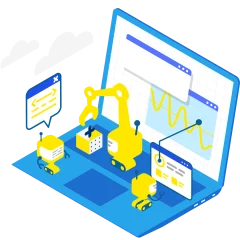In software deployment, containerization means isolating applications in so-called containers. The applications packaged in images include everything required to run the application: software code, runtime environment, system tools, libraries and settings. The special feature is that they are separated from the rest of the operating system and have their own environment. This means that they can run on different computers or servers without any compatibility problems – regardless of whether they run on MacOS, Windows or Linux OS.
Areas of application
Containerization is primarily used for cloud applications. Thanks to the simple scalability of the applications and the efficient use of resources, it is popular with everything from small start-ups to large companies. However, containerization is particularly useful in the development of microservices, where applications are divided into smaller, independent parts.
However, it is not only a component in software provision (i.e. hosting on the internet), but also part of the development process. Development teams rely on containers to ensure that apps run the same on every computer. If developer A is working on a MacBook with MacOS, but developer B is working on a Windows PC, compatibility issues are automatically eliminated. This is important for error prevention, as it ensures that every programmer finds and executes the same state of an application.
Technologies behind containerization
Docker is probably the best-known and most widely used technology in the field of containerization. If you look at the company’s logo, it quickly becomes clear why we are talking about containerization here:

But it shows much more that these containers are “shipped” together – i.e. delivered or provided. Colloquially, developers therefore also speak of shipping when they have released something.
The Docker platform offers the creation, distribution and execution of containers and thus sets a standard for container formats and operations.
Kubernetes: Orchestration of containers
Kubernetes is often used for more complex applications that consist of several containers. Kubernetes is API-based and its system provides automated provisioning, scaling and management of container applications. Container orchestration ensures, for example, that applications run reliably even with a high volume of visitors.
Kubernetes, or just K8s, is mainly used for cloud hosting. Originally developed by Google in 2014, it is offered by various providers, including Amazon with AWS, Google with its Google Cloud Platform itself, as well as Microsoft with Azure and numerous others.
Containerization vs. traditional virtualization
Compared to traditional virtualization, containerization has some significant advantages: While virtualization is based on the simulation of a complete hardware by a hypervisor, containerization works at operating system level. Containers also start faster and require fewer (physical) resources than virtual machines.
Practical use cases
By using containers, SaaS platforms and companies can develop, test and deploy applications in a controlled, consistent environment. Processes become more fluid and recurring errors are eliminated.
In our opinion, the use of containerization is always recommended. Because one way or another, most developers, like us, work with containers. It therefore makes sense to extend the ecosystem to staging and production systems in the target environment.
Because the additional effort is not great: most developers already have templates, so-called Dockerfiles, for common frameworks and software to quickly containerize existing applications. If not, such a configuration file can be created. Once created, it rarely needs to be adapted during the course of the project.
Benefits of containerization
With their efficiency, portability and consistency, containers are unbeatable when it comes to software development and deployment. By isolating applications in containers, conflicts between different software environments are avoided.
The resulting reliability and agility considerably simplifies software development and deployment.


